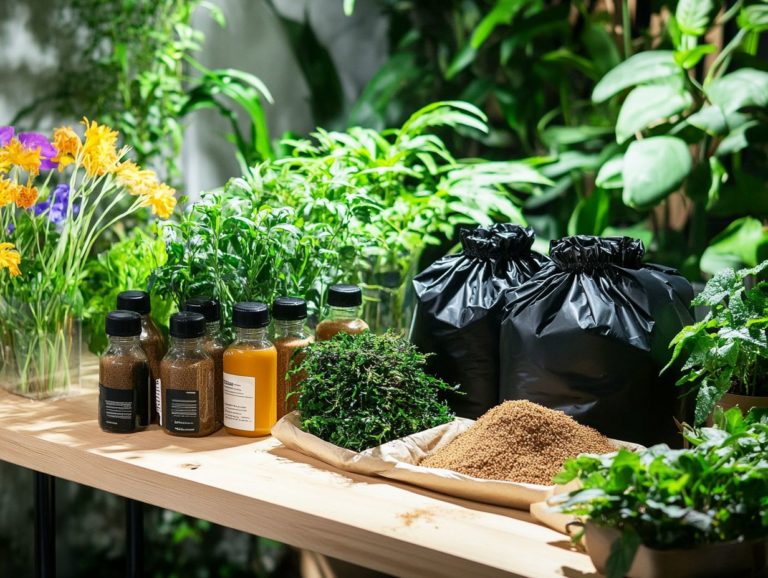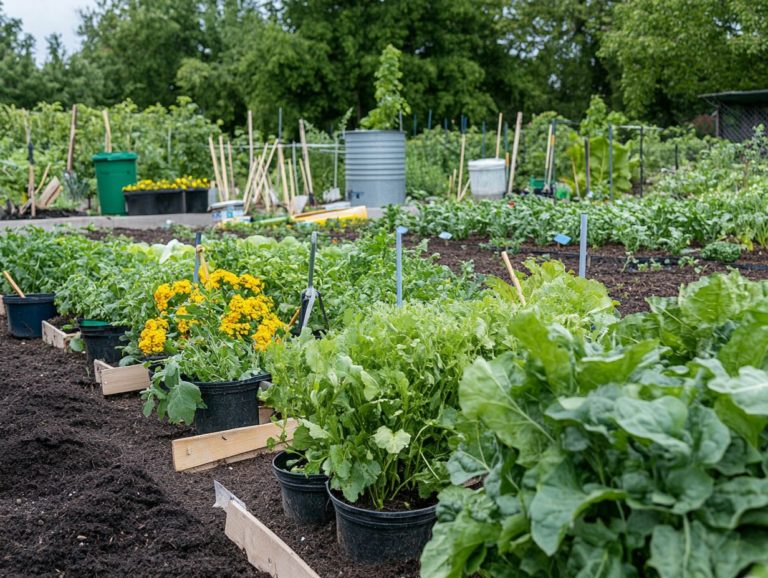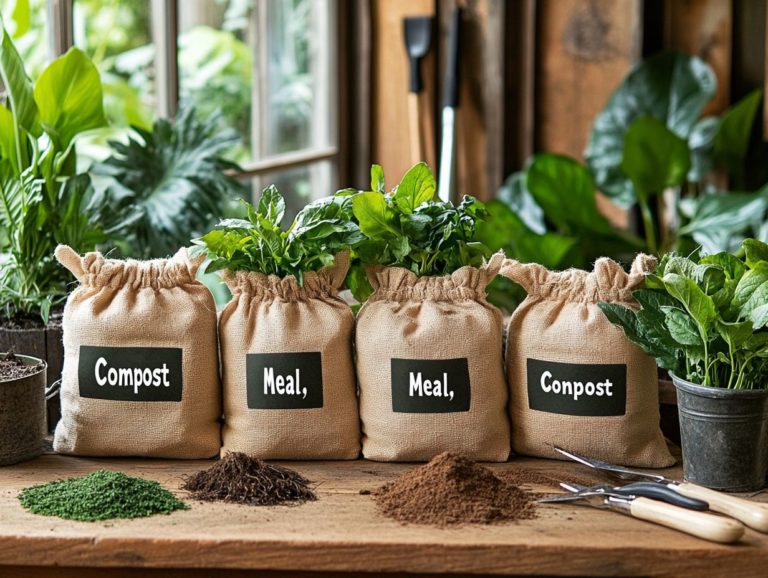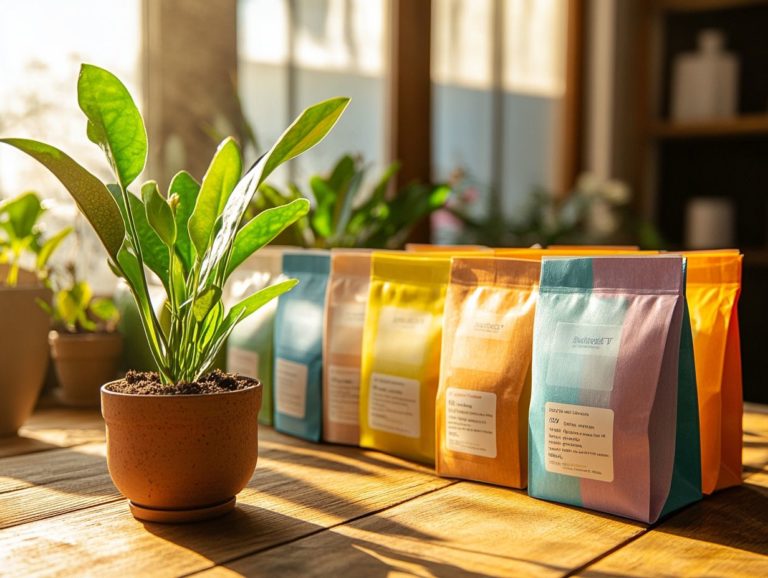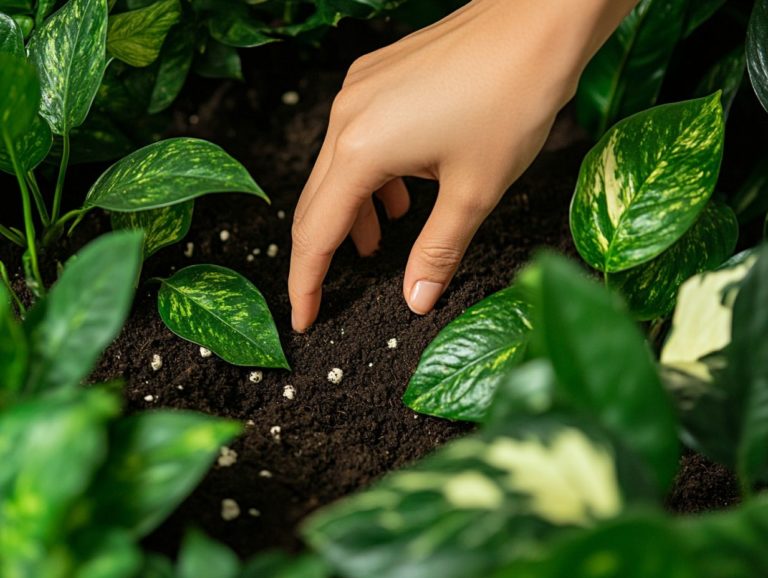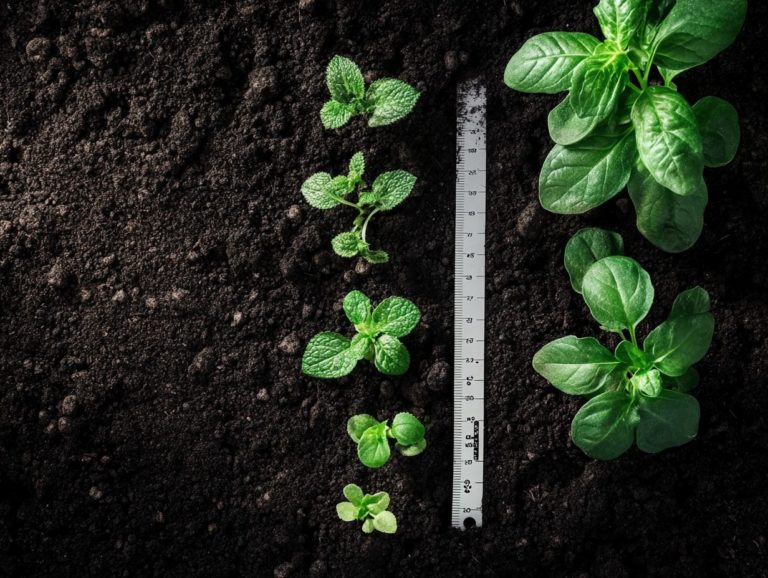When to Repot Indoor Plants: Soil Considerations
Repotting your indoor plants, particularly tropical houseplants, is more than a simple task; it s essential for their health and longevity.
Understanding the benefits of repotting, recognizing the signs that indicate it s time for a change, and selecting the right potting mix can significantly enhance your plant care journey. This guide will equip you with the knowledge to know when your plants need repotting, assist you in choosing the best soil types and fresh potting options, and offer you a step-by-step approach for a successful repotting experience.
Essential maintenance and potting tips will help your newly repotted plants thrive. Get ready to transform your indoor garden into a lush paradise!
Contents
- Key Takeaways:
- Why Repotting is Necessary for Indoor Plants
- Signs that Your Plant Needs to be Repotted
- Find the Perfect Soil for Your Plants!
- How to Repot Indoor Plants
- Maintenance Tips for Newly Repotted Plants
- Frequently Asked Questions
- When should I repot my indoor plants?
- What are the signs that my indoor plant needs to be repotted?
- What type of soil should I use when repotting my indoor plants?
- How do I know if the soil is too compacted and needs to be replaced?
- Can I reuse old potting soil?
- Do I need to add any fertilizer when repotting my indoor plant?
Key Takeaways:
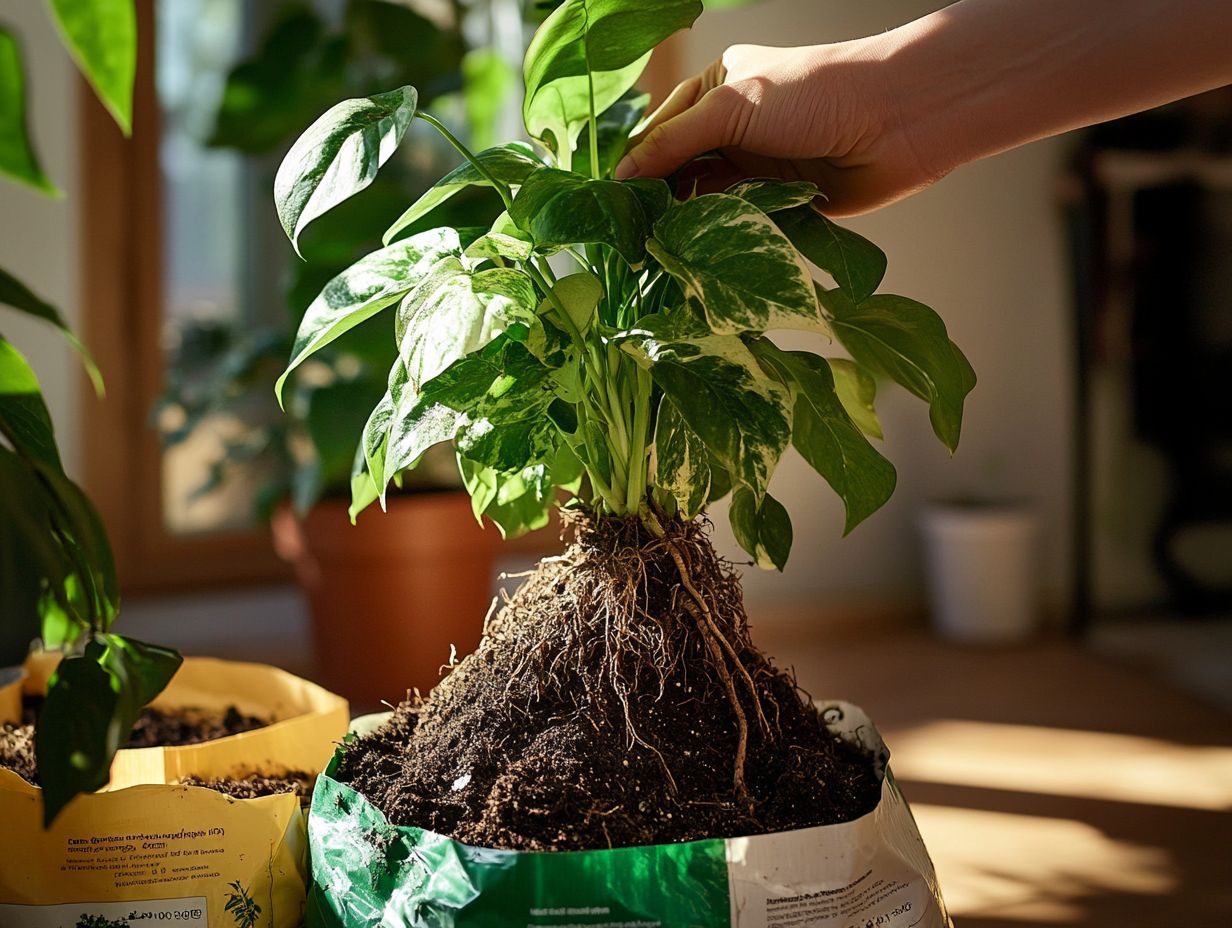
- Repotting regularly helps prevent root binding in indoor plants.
- Signs your plant needs repotting include roots emerging from drainage holes, stunted growth, and soil that dries out too quickly.
- When repotting indoor plants, choose a well-draining, nutrient-rich soil appropriate for the specific type of plant.
Why Repotting is Necessary for Indoor Plants
Repotting is essential for your plant care routine, ensuring that your indoor greenery thrives and remains in peak health, especially during the growing season. As your houseplants grow, they can become root-bound, which means their roots grow too tightly in their pot. This can lead to poor drainage, limited access to fresh nutrients, and issues like root rot.
By repotting correctly, you create an opportunity to introduce new soil, enhance moisture control, and provide ample space for growth, crucial for a thriving root system. This boosts your plants’ health and minimizes the risk of complications like root rot.
Benefits of Repotting
Repotting your indoor plants is a game-changer, offering numerous benefits that can significantly enhance their health and strength. By transitioning to fresh potting soil, your plants gain access to nutrient-rich materials that support growth and resilience. Improved soil drainage is also crucial for maintaining moisture control and preventing root rot.
This essential process prevents your plants from becoming root-bound, promoting overall health. A well-draining environment fosters better air circulation within the soil, encouraging healthy root development, especially for plants like cacti and succulents. Your houseplants will thrive in these conditions, leading to lush foliage and greater flowering potential.
For the best results, consider repotting annually or whenever you notice signs of restricted growth in your houseplants. By doing so, you help extend the life and beauty of your plants, ensuring they remain vibrant cornerstones of your indoor garden.
Signs that Your Plant Needs to be Repotted
Recognizing the signs that your indoor plants need repotting is essential for preserving their health and strength, especially for root-bound plants. Look for urgent indicators like roots emerging from drainage holes, stunted growth, and soil that dries out too quickly, as these are urgent signs that your plant needs immediate attention!
In some cases, you may even consider pruning the roots to encourage optimal growth, which is a key element of proper plant maintenance.
Identifying Common Signs

Identifying the common signs that your indoor plants need repotting is crucial for effective plant care. Look out for indications such as roots pushing through drainage holes, soil that dries out too quickly, and stunted growth. These signs mean your plant is ready for a new home!
For example, if you notice roots from your pothos cascading out of the bottom of its pot, it s a clear sign that it needs more space. You should consider container selection carefully. Similarly, when your snake plant’s leaves stop growing tall and vibrant, it’s time to give it a larger home.
If you ignore these signs, your plant’s health could quickly decline! Problems can arise, such as lack of nutrients, root rot, and overall decline in plant vitality. Timely repotting helps your plants thrive by providing necessary room for growth. It also refreshes the soil, allowing important nutrients and moisture to nourish your plant effectively.
Find the Perfect Soil for Your Plants!
Choosing the right soil for repotting is a crucial step in ensuring the health and vitality of your indoor plants, including tropical houseplants and orchids. Different types of plants whether you re nurturing tropical houseplants, cacti, or orchids have distinct soil requirements that cater to their unique needs.
By selecting an appropriate potting mix enriched with organic components and soil amendments, you can significantly enhance moisture retention, nutrient availability, and overall plant growth. This thoughtful choice fosters robust growth and keeps your plants thriving beautifully.
Understanding Soil Composition
Understanding soil composition is crucial for your success in repotting and maintaining the health of your indoor plants. A well-balanced potting mix typically consists of organic matter like peat moss or coconut coir. These components enhance moisture control and deliver essential nutrients while ensuring adequate drainage to prevent issues like root rot.
Your soil should also incorporate various mineral components, such as sand, silt, and clay. Each plays a pivotal role in your plant’s health. Sand promotes excellent drainage, preventing water from pooling around the roots, while clay retains nutrients for easy uptake. Silt aids in moisture retention, striking a balance that may vary depending on the specific needs of your plants.
By grasping this delicate interplay between moisture retention, nutrient availability, and drainage, you can tailor your potting mixes to create the optimal conditions for growth, flowering, and overall vitality of your indoor plants.
Best Soil Types for Different Plants
Selecting the right soil types for your plants, especially when considering container gardening, is essential for their growth and overall health.
Understanding the unique needs of various indoor plants like African violets or Ficus elastica will guide your selection process and help you maximize their potential. For instance, tropical houseplants thrive in a nutrient-rich potting mix that retains moisture. They particularly benefit from organic materials like peat moss and compost, which deliver essential nutrients.
In contrast, cacti and succulents flourish in specialized mixes that combine sand, perlite, or pumice. This ensures ideal drainage and aeration for their roots, which is crucial for avoiding root rot. Orchids prefer a chunky bark-based medium that mimics their natural, epiphytic environment, promoting air circulation and preventing waterlogged conditions.
Each of these soil selections plays a vital role in not just supporting but helping your plants thrive. This underscores the importance of thoughtful repotting decisions.
Check your plants today are they showing any signs they need a bigger home?
How to Repot Indoor Plants

The repotting process entails several crucial steps that are vital for successfully transplanting your indoor plants into new containers. Be mindful of your container choice.
Mastering proper potting techniques means selecting the ideal container size, preparing a fresh potting soil, and handling the root ball with care to avoid damaging the delicate roots.
Each of these elements plays a significant role in helping your plants adjust easily and fostering healthy growth during the potting process.
Step-by-Step Guide
A step-by-step guide to repotting indoor plants provides you with a simple, effective way to achieve successful plant maintenance and growth spurts. Start by selecting the right container, tailored to your plant’s specific needs.
- Remove the plant from its old pot, assess the root system, and introduce fresh potting soil to enhance its overall health.
- With the old pot out of the way, it’s essential to gently untangle any tightly bound roots. This promotes healthy growth and helps you avoid future issues.
- Next, don’t forget to trim away any dead or damaged roots; this simple act can significantly boost your plant’s vitality.
- Once that’s done, fill the base of the new pot with an appropriate potting soil that ensures good drainage.
- Position the plant securely at the right depth, then add additional soil around the sides, pressing gently to eliminate air pockets.
- After you’ve watered your freshly repotted plant, place it in a spot with indirect light to help it acclimate to its new surroundings.
This thoughtful approach paves the way for a thriving future in your indoor gardening efforts. Understanding why soil quality matters for indoor plants is also crucial for success.
Maintenance Tips for Newly Repotted Plants
Want your new plants to thrive? Keep them happy with these maintenance tips! Maintenance tips for newly repotted plants are crucial to help them adapt and thrive in their new environment. By following a thoughtful watering schedule that takes soil moisture levels into account and providing essential nutrients, you can greatly enhance their recovery and growth after repotting, particularly during the spring planting season.
Watering and Fertilizing Guidelines
Watering and fertilizing guidelines are crucial for maintaining the health of your newly repotted plants, especially as they adjust to their new potting soil. Understanding soil moisture levels will help you create an effective watering schedule, while timely application of plant nutrients supports robust growth during this critical acclimation phase, ensuring the best results in your plant care routine.
Check the soil moisture regularly for the best results; striking a balance between water and aeration is key. Newly repotted varieties often need frequent yet light watering to prevent root rot, particularly in those initial weeks. Incorporating a balanced, slow-release fertilizer or fresh nutrients can enhance nutrient availability, promoting strong foliage, healthy root development, and a robust root system.
Keep a close eye on your plants for signs of stress, like yellowing leaves or stunted growth. This vigilance will allow you to adjust your watering frequency, fertilizer type, and pruning roots as needed. By adopting these best practices for plant care, including watering schedule and potting tips, you ll not only nurture the health of your indoor plants but also cultivate a flourishing indoor garden filled with tropical houseplants.
Frequently Asked Questions

When should I repot my indoor plants?
It is generally recommended to repot indoor plants every 1-2 years, or when they become root-bound. Root-bound means the roots have grown so much that they are crowded in the pot.
What are the signs that my indoor plant needs to be repotted?
Some signs that your indoor plant needs to be repotted include roots growing out of the drainage holes, the soil drying out too quickly, or stunted growth.
What type of soil should I use when repotting my indoor plants?
When repotting indoor plants, use a well-draining, nutrient-rich potting mix specially formulated for them. Avoid garden soil, as it can contain pests and diseases.
How do I know if the soil is too compacted and needs to be replaced?
If the soil feels hard and doesn t absorb water easily, it may be too compacted. Check by gently squeezing the pot; if it feels very firm, it s time to repot.
Can I reuse old potting soil?
It s not recommended to reuse old potting soil. Over time, it becomes low in nutrients and may harbor pests that can affect your plant’s health.
Do I need to add any fertilizer when repotting my indoor plant?
Adding fertilizer isn t necessary when repotting. The fresh potting mix provides enough nutrients for your plant. You can add a slow-release fertilizer or a diluted liquid fertilizer on top of the soil if you want.

